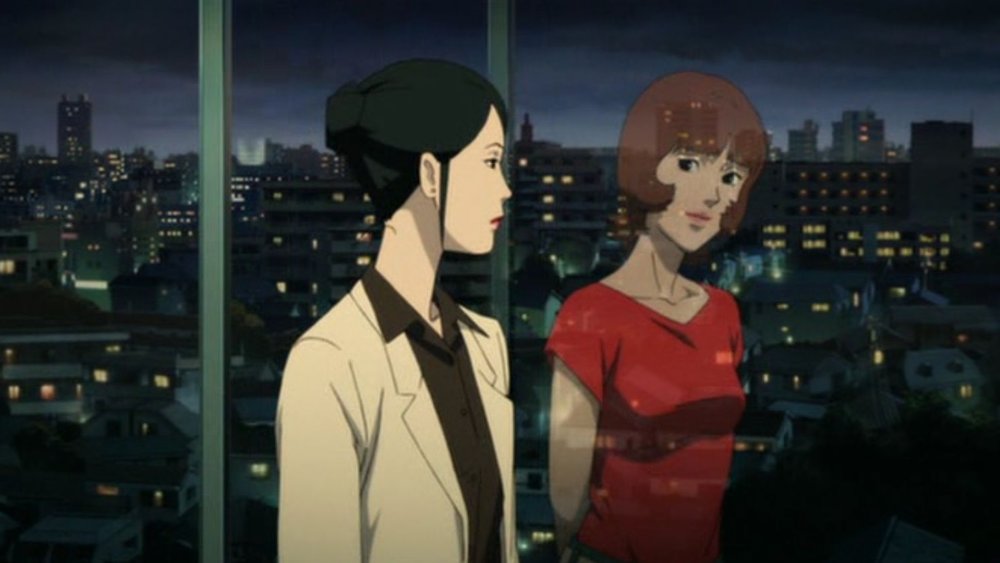Paprika (2006) is a Japanese film directed by Satoshi Kon. It was based on Yasutaka Tsutsui's novel from 1993.
 |
| Fig. 1, Movie Poster |
Two of the main characters, Atsuki Chiba and Paprika, are slowly shown to be connected until it's revealed that they are the same person. Paprika is thus shown to be Atsuki's projection of herself on the dreams. This is played with later in the film as we see both Atsuki and Paprika interacting with each other and other people within the final dream.
One of the reasons the film was created using animation over live-action with CGI is because some scenes would be easier to show through animation. This is in part due to expense as well as technological limitations. One scene that demonstrates this is when Atsuki is revealed inside Paprika as while the scene may have been possible in CGI it would have been more challenging and expensive to do.
The film warps and shift the images seen frequently throughout the film. This leads to fluid transitions between being awake and dreaming as well as showing the slow way fantasies can be found more interesting by people than the reality they live in. During one dream in particular, a parade of inanimate objects are shown. In an interview Satoshi Kon said that 'for viewers to identify with this dream, I chose a parade which makes one think automatically of other common dreams and unconscious states. There are very old characters like objects that are discarded by people today or religious symbols that people have forgotten.'(Pais, 2006). This dream formed a shared dream in which the dreamers are dragged into the dream and lose all sense of themselves outside of the dream world. The mass of objects in the dream 'works to one of the film’s themes, namely that our fantasies, including those opened up by the Internet, are pulling us away from the material world and, perhaps, more dangerously from one another.' (Dargis, 2007). This is further shown in how one of the entrances to the dream world is through a virtual bar one of the main characters logs into. He gets brought into the bar as if he were truly there and interacts with everything as if it were real.
Reality in the film slowly declines as the film progresses. This begins when Chiba hops over a fence at an amusement park only for it to warp and reveal she was about to hop over a balcony instead (shown in Figure 4). This is the first instance the audience encounters that shows reality shifting in the same way dreams would. This is in the film said to be due tot he amount of time spend within the DC Mini and that the longer spent in there the easier it is to slip into a dream without realising even when awake.
Bibliography:
- Dargis, N, (2007), [Online], http://www.nytimes.com/2007/05/25/movies/25papr.html (Accessed on: 05/02/18)
- Pais, J, (2006), [Online], http://screenanarchy.com/2006/10/paprika-interview-with-satoshi-kon.html (Accessed on 05/02/18)
Illustration List:
- Figure 1, Movie Poster, http://www.imdb.com/title/tt0851578/
- Figure 2, Reflections, http://www.talkfilmsociety.com/columns/fresh-eyes-paprika-2006
- Figure 3, Paprika is Atsuka, http://www.interrogatingideologywithachainsaw.com/2014/06/paprika-2006.html
 |
| Figure 2, Refleection. |
 |
| Figure 3, Paprika is Atsuka |
 |
| Figure 4, Losing Reality. |
Bibliography:
- Dargis, N, (2007), [Online], http://www.nytimes.com/2007/05/25/movies/25papr.html (Accessed on: 05/02/18)
- Pais, J, (2006), [Online], http://screenanarchy.com/2006/10/paprika-interview-with-satoshi-kon.html (Accessed on 05/02/18)
Illustration List:
- Figure 1, Movie Poster, http://www.imdb.com/title/tt0851578/
- Figure 2, Reflections, http://www.talkfilmsociety.com/columns/fresh-eyes-paprika-2006
- Figure 3, Paprika is Atsuka, http://www.interrogatingideologywithachainsaw.com/2014/06/paprika-2006.html
- Figure 4, Losing Reality, https://cinemaoftheabstract.blogspot.co.uk/2016/06/paprika-2006.html

No comments:
Post a Comment